Expansion of university education and graduate unemployment
Prof. Gamini Samaranayake - Chairman University
Grants Commission
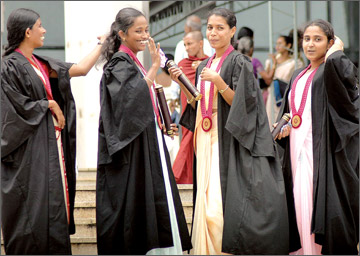 The paper is divided into five major sections. The first part
examines the origin, development and present status of university
education in Sri Lanka. The second part deals with the profile of
graduate unemployment, the third part examines the causes of graduate
unemployment, the fourth part examines graduate employability, and the
responses of the government to graduate unemployment, the fifth part
deals with the knowledge hub, advantages, opportunities and challenges,
while the final part of the paper deals with the observations and
suggestions. The paper is divided into five major sections. The first part
examines the origin, development and present status of university
education in Sri Lanka. The second part deals with the profile of
graduate unemployment, the third part examines the causes of graduate
unemployment, the fourth part examines graduate employability, and the
responses of the government to graduate unemployment, the fifth part
deals with the knowledge hub, advantages, opportunities and challenges,
while the final part of the paper deals with the observations and
suggestions.
Source: University Grants Commission
It is generally assumed, that there were 25,000 unemployed graduates
in 1998.
It is evident that more arts graduates were unemployed than graduates
from other disciplines and this trend continues.
Gender disagregated information indicates that female graduates have
higher unemployment rates than their male counterparts.
In 1971, out of 3,898 unemployed graduates 2338 were females which
indicate that 60 percent of the unemployed graduates were females. In
1989/91 out of 4,798 unemployed graduates 3,069 were female while in
1985 and 86 out of 5420 unemployed graduates 3417 were female. This
shows a feminization of graduate unemployment.
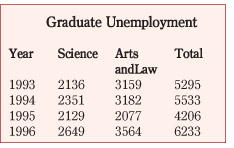 In analyzing the perceptions and attitudes of male and female
graduates some significant variations were noted. In terms of job
preference unemployed female university graduates prefer school teaching
than government administrative jobs or private sector managerial jobs.
Male university graduates prefer government administrative jobs than
teaching or private sector managerial jobs. In analyzing the perceptions and attitudes of male and female
graduates some significant variations were noted. In terms of job
preference unemployed female university graduates prefer school teaching
than government administrative jobs or private sector managerial jobs.
Male university graduates prefer government administrative jobs than
teaching or private sector managerial jobs.
However, males and females prefer to work in the public sector than
in the private or NGO sector. Moreover, more female graduates are
reluctant to work in the private sector than their male counterparts.
Graduates on the whole are reluctant to set up self-employment schemes
and believed that the government should provide them with jobs.
The preference of female graduates for the teaching profession could
be based on the fact that it is a profession with five to six hours of
work coupled with three months of school holidays which permits women to
balance their productive and reproductive roles.
Underemployment is a significant aspect of graduate unemployment
which often remains unrecognized and is seldom analyzed as an issue.
Unlike unemployment, underemployment eludes definition and assessment.
It can be described generally as a situation in which a person is forced
to accept employment below his or her educational level. It
predominantly affects the social science graduates.
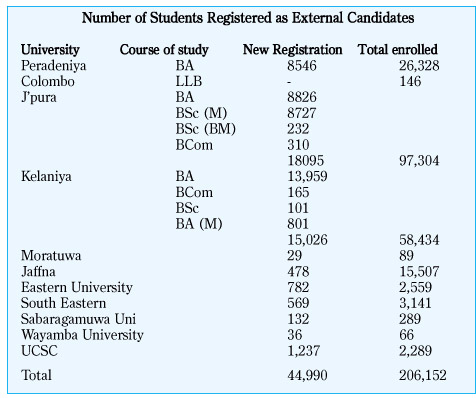 Definite statistics on underemployment are not available, but are
identified on the basis of low earnings. Around 14,000 graduates were
employed in the work force after 1970, but 80 percent of them received
salaries between Rs. 200 to 300 per month, which placed them below the
poverty line. Definite statistics on underemployment are not available, but are
identified on the basis of low earnings. Around 14,000 graduates were
employed in the work force after 1970, but 80 percent of them received
salaries between Rs. 200 to 300 per month, which placed them below the
poverty line.
Graduates who were employed under schemes on the eve of the General
Election in 1994 received a monthly salary of Rs. 2500. It is the salary
received by a worker in a garment factory. Due to limitations in job
opportunities, in the public as well as the private sector and
widespread underemployment the real value of university education has
eroded.
In this context, unemployment and underemployment is not the sole
problem: the means of securing employment is another aspect of the
problem of graduate unemployment in the country. There are three main
avenues used to obtain employment. The first is applications for jobs in
response to advertisements. The second is the assistance of family
members and/or friends and the last but not least the assistance of
politicians.
During the colonial period there was a trend towards white collar
employment on the basis of one’s family and personal contacts. This
system of obtaining employment enabled the students belonging to
families with influence to secure stable jobs, while the students in the
rural sector who invariably belonged to the peasant families were at a
grave disadvantage.
Currently, the most prevailing avenue has been assistance of the
government in power either voluntarily or through pressure of agitation.
Causes of graduate unemployment
To a certain extent we should also recognize that employment
opportunities for graduates are highly dependent on the economic growth
of the country. The slow rate of economic growth and the allied problem
of providing increased economic opportunities for the growing numbers
entering the labour market led to a high level of unemployment among
graduates especially from the social sciences and humanities. Apart from
national economic issues, there are a number of causes which have been
identified as contributory factors to the origin and development of
graduate unemployment.
Of these an ad hoc expansion of the universities and student
population, the nature of the courses, and quality of the graduates is
noteworthy.
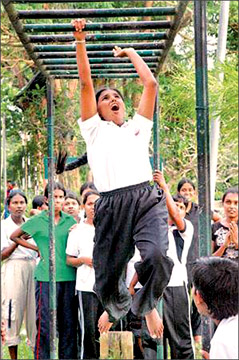 Since these factors are related to the expansion of higher education
in Sri Lanka, it is necessary to examine the context of the development
of university education. Since these factors are related to the expansion of higher education
in Sri Lanka, it is necessary to examine the context of the development
of university education.
The University College that was established in 1921 expanded to the
University of Ceylon by 1942. The university had only four faculties,
and a limited number of students offering for the degree of BA, BSc and
MBBS.
However, the entrance of students was limited compared to the
enrollment of students in primary and secondary education upto the early
1960s. There were 904 students in 1942, 1294, in 1947 and 48 and 2471 in
1956 and 7. The language of instruction was English and its students
were drawn from the English speaking urban middle class.
It was fashioned essentially on the Ox-Bridge model, and the
curriculum, the teaching learning process and examinations of the
university followed the pattern of British Universities. It was exactly
the model of elite education.
However, university education underwent many changes especially with
the granting of universal franchise in 1931, free education in 1945, the
political changes in 1956 and the introduction of university education
in Sinhala and Tamil Languages in 1959. It marked the beginning of the
inclusion of students from a wide ranging socio-economic background.
Consequently, the number of universities increased from one in 1942 to
three in 1960. Two of these new universities Vidyodaya (Kelaniya) and
Vidyalankaraya (Sri Jayewardenepura) were Buddhist pirivenas (monastic
institutions) which were elevated to the status of universities.
To accommodate an increased demand of university education ad hoc
measures were taken by the government such as elevating three affiliated
colleges as Universities namely Rajarata, Wayamba and Sabaragamuwa. By
1970 the number of universities increased to five and by 1978 there were
seven universities in the country. The rest were established after 1994.
The number of students entering higher education thus increased from
1612 in 1948, to 5000 in 1959, to about 14,000 in 1970 and 17,449
student enrolments in 1978. By 1988 and 89 there were 29,781 students
internally in university education.
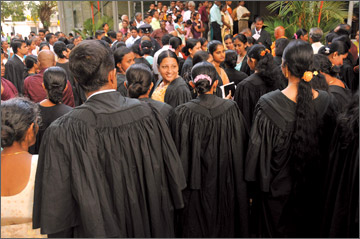 At present, 80,000 students are in universities. Annually about
13,000 internal graduates pass out from universities and more than 50
percent of them are from the Arts and management streams. At present, 80,000 students are in universities. Annually about
13,000 internal graduates pass out from universities and more than 50
percent of them are from the Arts and management streams.
The output of external graduates is around 6,500 and the Open
University too has an output of about 500 per year. Thirty years ago 70
percent of the student population was admitted to the faculties of
Social Sciences and Humanities.
In addition, since 1962, there has been a system of external
examinations in university education and almost 200,000 students are
registered with the eleven universities in the country. Table 2 shows
the number of students and courses offered by the external students
registered with our universities.
Not only did the number of students and institutions dealing with
higher education expand but the socio-economic composition of the
student population and the quality of education, too changed over the
years.
The most significant feature of this rapid growth is the changing
socio-economic composition of the student population in the period 1959
up to date.
There are a few systematic studies on the socio-economic background
of the student population mainly by Murray A. Strauss in 1950, and J E
Jayasooriya in 1965.
These students mainly belong to the urban middle class social
background. Moreover, they had no anxiety about their own future
because, after graduation, they were assured of employment in the higher
echelons of government or the private sector.
This trend began to change in the mid 1960s. Since then a substantial
proportion of students tended to come from the lower middle class, the
working class and the peasant class.
The concentration of students from such social backgrounds is the
strongest in the faculties of Arts, Social Sciences, Humanities and
Commerce and Management.
 Besides, a majority of the university students are by ethnicity
Sinhala, by religion Buddhist and are from the rural sector. This trend
further developed as a result of the “standardization”, and “district
quota system” introduced in 1973. Besides, a majority of the university students are by ethnicity
Sinhala, by religion Buddhist and are from the rural sector. This trend
further developed as a result of the “standardization”, and “district
quota system” introduced in 1973.
According to the University Grants Commission (UGC) Statistical Hand
Book of 1988/89, the occupational background of the parents of the
students admitted in the academic year belonged to the low-income
category.
Nearly 40 percent of the parents of the students earned a monthly
income of less than Rs. 1000. As given in Table 3 an analysis of the
University Entrants by parents Occupation for the Academic Year 1950 and
1977 shows the changing socio-economic background of the student
population.
According to this analysis there is a decline in the number of
students whose parents have a professional or managerial background
while there is an increase in the number of students whose parents are
small farmers or rural workers.
In spite of the increasing number of universities and the number of
students the curriculum, the teaching learning process, and the
relevance and quality of education remained unchanged.
A sample survey based on the student population at the University of
Peradeniya indicated that 62 percent of students are disappointed of the
highly theoretical lectures, lack of practical exposure to industry,
lack of industrial training, poor teaching techniques, lack of
application of education technology in teaching, and poor relations with
the private sector.
The expansion of the student population, the introduction of
Suwabasha education at university level and the changing socio-economic
composition of the student population changed the education system from
an elitist to a mass system.
An elitist system emulates the western model of education with a
strong western philosophical bias. The students who undergo the elitist
system of education expect to be assimilated to the elite circles and
are therefore guided to conform.
Students in the mass system are more prone to political activities,
and are less likely to align with the political elite. Thus, the
transition of university education from an elitist to a mass resulted in
a high level of political dynamism among the student population.
Source: G Samaranayake, 1992 p16
The universities in Sri Lanka depend solely on the state for funds.
However, the budgetary allocations for higher education over the years
failed to meet the demands of the expansion in the system leading to a
concomitant reduction in facilities.
The lack of qualitative improvement in university education has been
a major manifestation of the lack of financial resources made available
for tertiary education. From 1959 to 1966 and 67, the total real
expenditure on university education rose by only 27 percent while the
student enrolment had increased as much as 278 percent or tenfold.
 The available statistics indicate that government expenditure on
university education is 1.4 percent of government expenses and 0.34
percent of the Gross Domestic Product (GDP). One can conclude,
therefore, that university education has been provided for a
significantly larger number with very little increase in the total
resources diverted to it, thereby reducing its quality to a great
extent. The available statistics indicate that government expenditure on
university education is 1.4 percent of government expenses and 0.34
percent of the Gross Domestic Product (GDP). One can conclude,
therefore, that university education has been provided for a
significantly larger number with very little increase in the total
resources diverted to it, thereby reducing its quality to a great
extent.
Furthermore, the problem of graduate unemployment has increased due
to limitations in the expansion of the State sector as a result of
economic liberalization, structural changes and privatization of
cooperation’s and other public ventures.
Graduates who have studied Commerce and Management Subjects are more
open to the prospects of working in the private sector than Social
Science graduates.
Graduates are unable to secure employment in the private sector
mainly due to the mismatch between the skills of the Social Science
graduates and the needs of the private sector which has expanded during
the past decades,
One of the main criticisms aimed at university education including
the Central Bank Report of Sri Lanka for 2009 is that higher education
is of “low quality and low standards and that 32 percent of students
admitted to national universities study social sciences and humanities
and a substantial proportion of these graduates find it difficult to
obtain productive employment.
The same report concludes that “the country has a supply driven
education system with little relevance to labour market conditions and
to entrepreneurial culture”.
However, graduate unemployment is not purely a university problem but
universities have a responsibility and accountability to extend all
their support to solve the problem.
Graduate employability
Currently at global level universities are very much concerned with
graduate employability as a means of overcoming the problem of graduate
employment. As an acceptable definition of employability, the best I
could find stated that “employability is a set of achievements,
understanding and personal attributes that make an individual more
likely to gain employment and be successful in their chosen occupations,
which benefit themselves, the workforce, the community and the economy”.
Employability thus defined has wider interpretations and connotation
especially for a developing country like Sri Lanka grappling with issues
of political violence, poverty and rehabilitation arising from manmade
and natural disasters.
A survey conducted by the Chamber of Commerce in Sri Lanka in 1999
has mentioned that the following attributes are expected by the private
sector employers from the graduates in addition to their academic
qualifications.
They are as follows: ability for effective communication skills along
with English; ability of interpersonal relationships, ability of leading
a team and getting the results within a short time; ability of
prioritization of work; initiation of work and intention of its
development; open, proactive and pragmatic mind; computer literacy,
ability of logical and rational thinking, general knowledge and personal
hygiene, office and social etiquette.
A similar study conducted by the Council for Industry and Higher
Education in the United Kingdom (UK) in 2008 found that employers rate
communication skills, team work, integrity and intellectual ability over
literacy and numeracy.
It is suggested that students are provided with opportunities to
access and develop everything on the lower tier of the model such as
career development learning; Experience (work and life); Degree subject
knowledge, understanding and skills; Generic skills and Emotional
Intelligence; and essentially opportunities to reflect and evaluate
these experiences, which will result in the development of higher levels
of self-efficacy, self-confidence and self-esteem- the crucial links to
graduate employability.
The above mentioned study and survey confirms that employers prefer
social skills and personality type as more important than the degree
qualifications to meet the demands of a market driven and knowledge
based economy. This study also found that the services delivered by the
university careers advisory services to be unsatisfactory.
In developing the strategic plan for the UGC for the years 2008-2012
we analyzed these issues in some depth. We were surprised to learn that
none of the donors, policy makers and planners had conducted a
comprehensive study of the needs of employers such as the study done in
the UK.
The universities in the UK are also striving to address issues of
employability as evidenced in their websites such as the University of
Hull and Wolverhamption.
This is a gap that we in Sri Lanka need to fill to fully understand
the employability of our graduates and the mismatch between the
requirements of the employers and the education provided by the higher
education system. The Ministry of Higher Education and the UGC has
expanded IT facilities at our universities, introduced a system of
lateral entry, revised the curricular and introduced new courses,
placement years in collaboration with the private and public sector and
established a system of career counselling in universities.
However, more in-depth analysis is needed on the current skills of
our students, the needs of employers both in the private and public
sector and the recruitment patterns and policies of employers for us to
fully understand the issue of employability.
However, it is my contention that we need to consider some critical
factors that are confined to our higher education system as well as our
country context.
One of the main factors is that the universities cannot impart
critical skills such as problem solving, analytical thinking and
interpersonal skills required for employability within the three or four
years that students spend at the university. Students need to acquire
these skills through a Good Early Childhood Care and Development
Programme that is regulated, has quality standards of reference and a
sound system of assessment.
The formal education system needs to follow up with a well
constructed curriculum that is implemented effectively across the
country. The component titled preparing for the “ world of work” was
introduced recently to secondary education but its implementation
remained varied and poor. Therefore, the education system from ECCD to
secondary education needs to be aligned to the basic objectives of
increasing the skills of children. The universities can assign higher
priority to imparting language and IT skills so that meaningful changes
can be made in the higher education system concomitantly.
The second factor derives from our country context. What is the
reality in our universities? Any form of change is resisted with
political overtones and the policy makers and administrators are
challenged every step of the way in bringing about changes in the
system.
This subculture is manifest in the high degree of politicization in
the universities which are currently the base for insurrectionary
politics as exemplified by the violence in universities whether it is
political factionalism or “violent ragging”. This subculture of violence
resists any form of change and the silent majority is penalized by a
violent few.
The third factor is that employers in the private sector and employer
groups keep saying that universities need to do more to improve graduate
employability. But employers too need to contribute their share by
working more closely with the universities, the UGC and the Ministry of
Higher Education to develop a system of identifying the skills young
graduates need to prepare them for the world of work.
Currently, a few universities are trying to address the issue of
graduate employability strategically. However, these universities need
both financial and human resources to diversify and increase
employability.
We also need to train our academic staff, to invite professionals
from the private sector to teach at our universities and expand
opportunities for graduate students to acquire skills.
Government’s response
In this context, it is necessary to examine the measures taken by the
government to solve or contain the problem of graduate unemployment in
the country. Since 1970, governments have introduced a special
employment programme for graduates.
The government has recruited graduates as teachers, development
officers and trainees in the graduate scheme in order to ease the
problem of unemployment.
The government from 1970-77, found it necessary to address this
problem and as a result introduced the system of appointing a political
authority for each district. The political authority was a Member of
Parliament belonging to the political party in Office.
The system further stipulated that a person seeking a job had to
obtain a letter of recommendation from the political authority. This
represented a form of patron-client relationship and proved to be a
barrier hampering those supporting any Opposition political party from
securing employment.
The UNP government which came to power since 1977 introduced the
system of a “job bank”. This system also created ways and means of
practicing corrupt practices such as bribery. The lack of personal
contacts, political or bureaucratic patronage and corrupt practices in
securing employment has posed additional barriers to graduates seeking
employment.
However, the state has found it increasingly difficult to absorb
graduates into the shrinking ranks of the public sector. Successive
governments have been compelled to seek the assistance of the private
sector to solve the problem of unemployment among graduates. Since the
early 1990s, the government has set up a scheme for graduate trainees
within the private sector.
The Programme offers two-three years of training in private companies
at a monthly allowance of Rs. 1500. There is to be no guarantee of
placement at the end of the training.
However, nearly 9000 applications have been processed for this
programme.
Prior to the General Election of August 1994, the government opened a
trainee scheme for unemployed graduates, which absorbed a majority of
the unemployed graduates at that time.
In 1997, the government inaugurated a new scheme called the Tharuna
Aruna with the private sector to address the same issue. The main
objective of the programme was to develop the knowledge, skills and
attitudes of unemployed graduates in order to enable them to secure
employment in the private sector. Under this scheme placements have been
offered to 1130 graduate trainees in 345 companies during the period
1997-1998.
In 2004 about 42,000 graduates were absorbed as teachers and office
workers. However, a majority of them do not have any promotion scheme or
career path and are still underutilized.
The Higher Education Ministry has embarked on several programmes and
initiatives to mitigate the problems of unemployed graduates. These
initiatives among others are the introduction of skills modules to
increase communication skills, leadership and team building into the
students’ pre-orientation programme, basic entrepreneurship modules,
industrial training programmes, and collaborative programmes with
relevant professional bodies.
Various measures have been initiated by the UGC and universities to
enhance graduate employability over the last few years. Carrier Guidance
Units are established in each and every university under the supervision
of the Standing Committee of the UGC. While increasing the number of
university admissions into Science oriented faculties the intake to Arts
courses in Universities has remained relatively static at around 5,000
students.
Steps have been taken to improve the quality of the degree programme
on the basis of international bench marks. During the last few years,
the Higher Education Ministry together with the UGC worked on Improving
Relevance and Quality of Undergraduate Education (IRQUE) a project
designed from a loan given by the World Bank to improve the quality of
university education.
Furthermore, the medium of instruction has shifted from Sinhala and
Tamil to English. Universities need to do tracer studies before
convocations are held each year. The tracer study on graduate
employability has shown significant improvement on the marketability of
graduates in some universities.
A recent survey on Graduates of the University of Colombo has
revealed that more than 55 percent of Science and Management graduates
have found employment during three months after graduation while 12
percent and 16 percent of Arts and Education graduates respectively have
found employment. A similar study done by the Moratuwa University too
has revealed that more than 95 percent of the graduates of the Moratuwa
University that are qualified in the fields of Engineering and
Architecture have found employment within six months of their
graduation.
The prevailing idea is that it is the duty of the government to find
a solution to the problem of graduate unemployment. Although, the
government has emphasized the expansion of the private sector as a
solution to graduate unemployment, the graduates themselves are not
willing to join the private sector as it is a competitive field where
job security depends on performance.
The private sector on the other hand prefers proficiency in English,
personality and social standing. Although the Sri Lankan education
system produces a limited amount of human resources for Science and
Technology, the industrial sector is not capable of absorbing all of the
graduates from the disciplines of Science and Technology.
Many such graduates leave the country for foreign employment while
some are employed in non-technical disciplines indicating the lack of a
concomitant expansion in industry to absorb the Science and Technology
graduates. The private sector and the state sector needs to reconfigure
its recruitment, induction, training, mentoring and coaching system.
I have found that our graduates have the latent skills and capacity
to compete in the labour market but the employers themselves lack the
creativity, innovativeness, and capacity to develop a system of
recruitment, capacity building and coaching and mentoring young
graduates.
The solution can be found on a short-term as well as long-term basis.
The short-term strategies are for the government to invest in training
the unemployed graduates to acquire the competencies needed for the
modern work place and develop systems to link them to the world of work.
The long term solution lies with all of the stakeholders of higher
education: the government, private sector employers, universities and
university students.
The university educational system has to be re-oriented to meet the
challenges of graduate unemployment. The existing teaching and learning
process relies heavily on rote learning.
Traditionally, students are passive listeners, and they rarely
challenge each other or their professors in classes. Teaching focuses on
the mastery of content, not on the development of the capacity for
independent and critical thinking. Knowledge, skills and talent will be
crucial factors for growth in the future, while innovation and
willingness to change will be a driving force.
The university system needs to be re-structured, concerned with
quality and relevance, and introduce job-oriented programmes. Therefore,
the Ministry of Higher Education and the UGC plans to address issues
through long-term plans of change. Establishing Sri Lanka as a knowledge
hub in South Asia is one such option that is being explored.
Knowledge hub
A Knowledge Hub is broadly defined as a designated region intended to
attract foreign investment, retain local students, build a regional
reputation by providing access to high-quality education and training
for both international and domestic students, and create a
knowledge-based economy.
A knowledge hub is concerned with the process of building up a
country’s capacity to better integrate it with the world’s increasing
knowledge based economy, while simultaneously exploring policy options
that have the potential to enhance economic growth. An education hub can
include different combinations of domestic and international
institutions, branch campuses, and foreign partnership, within the
region. The main functions of hubs are to generate, apply, transfer, and
disseminate knowledge.
The concept of a knowledge hub for Sri Lanka was proposed by
President Mahinda Rajapaksa through his policy document during the
presidential election in 2009. It is stated that Sri Lanka will “develop
youth who can see the world over the horizon”. “We have the opportunity
to make this country a knowledge hub within the South Asia region. I
will develop and implement an operational plan to make this country a
local and international training centre for knowledge”.
The Higher Education Ministry is grappling with the empirical
implications of translating this promise into reality. The Ministry has
invited foreign universities to set up campuses to provide a more
diversified higher Education programme to increase access for local
students and to attract students from overseas to study in Sri Lanka.
Just as in Singapore Sri Lanka’s strategy is to piggy- back on
internationally renowned universities so that the process is cost
effective and mutually beneficial.
Furthermore, it is planned that 10 branch campuses of “world class”
universities would be established by 2013. The Knowledge Hub Agenda has
given greater prominence especially to the fields of Science and
Technology, Information and Communication Technology, Skills
Development, and Research and Development in Applied Sciences.
Advantages
Sri Lanka enjoys several advantages to develop into an education hub.
First, of all the ever increasing demand for higher education in the
country is an impetus for growth and advancement. Annually, well over
250,000 students sit for the Advanced Level Examination and half of them
are qualified for university education. However, only 22,000 are able to
enter university education in the country.
Of them, 9000 enroll in vocational training through 12 Advanced
Technological Institutes, 20,000 enroll at the Open University, 8000,
access overseas education, 20,000 register as external candidates while
9000 are studying for a foreign degree via cross border institutes.
Nearly, 60,000 students are looking for alternative higher education
locally.
To be continued |



